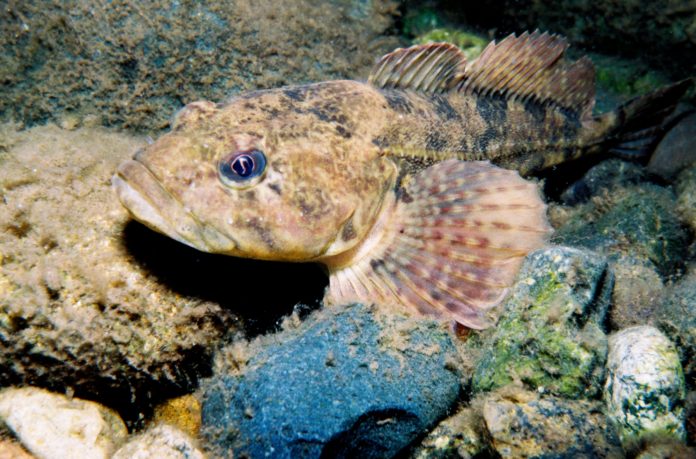Prickly sculpin (Cottus asper) demonstrates the classic sculpin shape: big head, wide fins, tapering body.
Photo by U.S. Fish & Wildlife Service
Ever since Don Gapen tied the first Muddler Minnow in 1936, fly fishers have recognized that freshwater sculpins (genus Cottus) can be important forage fish for trout, and there are now dozens of imitations of these odd-looking species. Even though most anglers have probably never even seen a live sculpin in the flesh, they could describe the fishes’ large head, wide fins, and sharply tapered body, based on the silhouettes of sculpin patterns. Some species of sculpins live in virtually all trout waters, from coast to coast, and they are usually abundant, which is why trout know to look for them. Large rainbow trout in Alaska have even been known to hunt for sculpins by bumping rocks on the streambottom with their noses to dislodge the baitfish.
Range and Species History
Freshwater sculpins are members of the family Cottidae, which also includes many saltwater species, mostly in the Pacific Ocean. Although you’ll find various figures for the number of species of freshwater sculpins in North America—ranging from 21 to 68, in my research—the truth is that scientists really don’t know how many there are because the differences between them are so subtle and because some species inhabit very small ranges. Because they are so widely distributed throughout the Northern Hemisphere, there are likely many more species than even the highest estimates.

The Slimy Sculpin (Cottus cognatus) inhabits cold rocky streams or lakes.
Artwork by Ellen Edmonson and Hugh Chrisp, courtesy NYDEC
Freshwater sculpins rarely exceed 7 inches in length, while the majority are considerably smaller, and they inhabit virtually every kind of habitat in which you’d also find trout, salmon, and smallmouth bass: from rocky, cool headwater streams, to lakes, to rocky areas of slower, meandering lowland rivers. Their flattened profile and wide pectoral fins allow them to hold tight to the bottom in even the fastest riffles. Masters of camouflage, sculpins usually display mottled colors that generally match that of their habitat, so a pattern to match the color of the substrate is always a good choice.
Sculpins are ambush predators that feed mostly on microcrustaceans and aquatic insects, although they will also eat small fishes (including each other), worms, and even crayfish. Anglers have long accused sculpins of feeding on trout eggs, but there is no scientific evidence to support this assertion.
Sculpin spawning is still somewhat of a mystery, although it seems that spawning behavior may be dictated by both species and habitat, with fish in warmer climes spawning earlier in spring and later in the fall. It is perhaps for this reason that, although sculpins are available to trout year round, anglers seem to have the most success with sculpin patterns early and late in the season. Fishing a sculpin pattern through deep holes can also be a product tactic during the winter months.

The Banded sculpin (Cottus carolinae) lives mostly in small to moderate sized streams in areas of swift current.
Photo by U.S. Fish & Wildlife Service
The Known Unknowns
Freshwater sculpins are difficult for biologists and fish managers to get a handle on because, as the U.S. Forest Service puts it, “The morphological differences between species are so subtle that even experts are occasionally baffled.” This makes it extremely difficult to study any one population or to determine how the ranges of different species overlap. In fact, we don’t even know how many species there are in North America, although there are certainly dozens, and the biodiversity of members of the Cottus genus is surely underestimated. The Forest Service has launched crowd-sourced data-collection programs in which citizen scientists are collecting fin clips, whole fishes, and GPS data to be entered in a large database that can then be studied.
Sculpin-Specific Tactics
Many anglers fish a sculpin the way they do any other streamer pattern, but there are other ways to do it. Because sculpins are bottom-dwellers, they behave differently from other baitfish. Try casting the fly quartering upstream, letting it sink deep, and then use very short, sharp strips to make the fly dart and stop along the streambottom. Dead-drifting the fly broadside to the current can also be effective, especially during high water. To fish the shallow tailouts of pools, cast quartering downstream, and then make a series of upstream mends to make the fly dart and swing slowly across the tailout. Sculpins are quick, elusive swimmers, so trout usually pounce on them aggressively to ensure success, so be ready for a hard strike.

The Muddler Minnow (top) has spawned some modern, articulated sculpin patterns, such as the Grumpy Muppet.
Photos via orvis.com
Sculpin Imitations
Don Gapen’s Muddler Minnow was popularized by Montana legend Dan Bailey—who codified the basic turkey, tinsel, and deer-hair pattern that most of us know—and proved its worth on trout streams around the world. In the decades since, fly tiers have come up with countless variations of the Muddler, as well as many other creative designs. Woolhead Sculpins replace the deer hair of Gapen’s original with sheep’s wool or similar synthetic materials, which offer a more realistic silhouette and sink more readily when wet. The Zuddler maintains the deer-hair head but replaces the stiff rear portion of the original with a slinky zonker strip, which offers more lifelike action in the water.
The recent trend in sculpin-fly design has produced some very large, heavily weighted flies. Flies with heavy cones or dumbbell eyes, such as the Sculpzilla and Whitlock’s Near-Nuff Sculpin, are designed to get to the bottom quickly, where the real sculpins life. Articulated patterns with large heads that push a lot of water, such as Galloup’s Woolly Sculpin or the Grumpy Muppet, are meant to attract the largest meat-eating trout in the river.
Credit: Source link






























